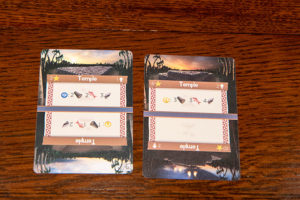 I’m sure many of us have discussed their “Desert Island Game” among friends. Much like book readers or movie fans have done, these are things you’d take with you if you were trapped on a desert island. Although just the thought of getting sand in any of my game components gives me the shivers.
I’m sure many of us have discussed their “Desert Island Game” among friends. Much like book readers or movie fans have done, these are things you’d take with you if you were trapped on a desert island. Although just the thought of getting sand in any of my game components gives me the shivers.
However, now there is a game both themed around being stuck on an island and also durable enough to be played on one. Say hello to Palm Island. Funded on Kickstarter earlier this year, Palm Island gives players a quick playing, filler game that literally plays in the palm of your hand.
Palm Island is an engine building microgame for 1-2 players that takes about 10 minutes to play. Palm Island plays best as a solo game.
Gameplay Overview:
Just like the name sounds, you play Palm Island in the palm of your hand. The game uses 17 cards in total (for the base game at least) shuffled and held in one hand. The first two cards of the deck are always accessible to you.

On your turn, you must do one of two things: Take an action or discard the top card of your deck. The different actions include:
- Store: Pay the cost (if any) and rotate the card 90 degrees clockwise. Then place it in the back of your deck. These are usually resources that can be used to pay for future cards and you are limited to 4 stored resources.
- Rotate: Pay any cost and rotate the card 180 degrees, placing it in the back of your deck. This is primarily a way to upgrade a card. Costs are paid with previously stored resources by rotating them vertically and moving them to the back of the deck.
- Flip: Pay any cost and flip the card over (front to back), placing it in the back of your deck. Again, this is another upgrade action.
If you can’t take any of the above actions, you simply discard the top card to the back of the deck.
When the round card makes its way to the front of the deck, the round ends and it’s rotated to the next round number and placed in the back of the deck. After 8 rounds, the game ends and you total up your victory points. There is a handy chart in the rulebook to see how well you did.

Game Experience:
With only 17 cards and a few core rules, Palm Island is as simple to play as it is to learn. Yet contained in this small packaging is a really clever engine building game. I’ll admit it, the first few times I played the game, I did horribly. I didn’t quite figure out the strategy and it all felt very random. Yet as I gained experience, I learned that while the shuffle does affect your outcome, it isn’t the only thing.

Palm Island is all about building the best engine you can as quickly and as efficiently as possible. With only 17 cards and 8 rounds, Palm Island is more of a time management game than a resource management one. Sure, you need rocks, wood, and fish to build anything, but if you don’t have those resources at the right time, or if you waste cards discarding to get to them, you are going to have a bad score. The early rounds are there to help set up the later rounds for big payoffs (upgrading to those high VP cards).
The biggest selling point for Palm Island though has to be its portability. As it’s literally played in the palm of your hand, this truly is a game you can play anywhere. In fact, we bought a new car recently and I played more than a handful of games while waiting at the dealership. It really helped pass the time.

Publisher Portal Dragon also made the game quite thematic by having the case be one of those waterproof cases you’d use on the beach. They even gave the cards a plastic coating to make them waterproof as well. Unfortunately, this had the downside of making the cards a bit too slippery and more than once, they slipped out of my hands. Since the order of the cards is critical to the game, this forced a restart. I would have much preferred a deck of cards with a less thematic finish that was a bit more tactile to hold.
With only 17 cards, the gameplay in Palm Island isn’t very deep. After a handful of plays, you’ll have seen most of what the game has to offer. Trying to get a high score though will most likely be the driver of further plays. And for me, it did. I’ve lost track of how many games I’ve played.
That being said, Portal Dragon did include a number of variants in the game to help with the replay value. There is both cooperative and competitive play, however, I had the most fun solo and would recommend sticking with that. There are also villager cards to help mix things up and even feat cards to give you something to shoot for with your high scores.
Final Thoughts:
I found Palm Island to be a creative game that excels at being something you can play on the go. It’s quick playtime and the fact that you don’t even need a table to play makes it perfect for travel. Palm Island easily fits in a purse or bag so it’s easy to always have on hand. I do wish that the cards were a tad less slick. I have to use a grip of death on them to keep them from slipping, causing more than a few hand cramps.
However, despite the lack of depth in the gameplay, I still found myself grabbing Palm Island of the shelf for a quick play here and there. The drive to get a higher score, and the unique mechanics, have made this tiny card game quite addictive.
Final Score: 4 Stars – A great little filler game that’s easy to take and play on the go.
 Hits:
Hits:
• Very portable, no table required
• Engaging mechanics are easy to learn and addictive
• Quick play time
• Variants and alternate play modes
Misses:
• Cards are a bit too slippery






















